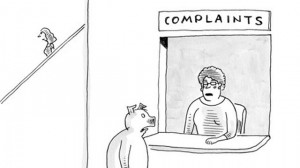And therein lies the rub: The New Yorker seems to be violating its own cartoon principles by constantly choosing caption finalists (like “Just water for me”) that are weak punchlines rather than august demonstrations of creativity and inventiveness. How did “Just water for me” even become a finalist? One of the also-ran captions, “Touch the fork and I’ll scream,” is, to me, a lot funnier. And therein lies a second rub: Mankoff says caption contestants may not share his standards of humor. Shorter captions are generally better, he says. So are captions whose last words have panache or verve. And it’s not just Mankoff choosing the finalists. He tells KQED that his assistant usually helps him winnow down the submitted captions. And he often uses computer programs to reduce the thousands of entries to a manageable level. Once the submissions have been thinned to fewer than 10, Mankoff sends these semifinalist captions to about 40 other New Yorker editors, who then give him crucial feedback before he chooses the three finalists, which appear in the magazine.
“My assistant always goes through the 5,000 (submissions) and he gives me a bunch,” Mankoff says in a phone interview. “I also have a program where I create random samples of a 100. Just random samples. And I just keep looking to see if anything strikes me. And I weed out the things that are very common. I also have another program that sorts by frequency of phrases, and the length of the caption. I have a program that looks at what the last word is, to see if the punch line is there. So there are rules of thumb combined with technology.”
This “technology” factor may surprise longtime contestants, but as Mankoff admits, “There’d probably be a better way to (judge the contest) but given the constraints of a weekly magazine, we don’t really have the resources to do that.”
The New Yorker, in other words, is fallible, and the cartoon contest may be the magazine’s most frustrating section because it’s the only one that involves crowd-sourced judging, and it’s the only one that invites so many submissions. The contest’s lack of consistency — where some caption finalists are side-splittingly funny and others are downright pathetic — is absent from the rest of the magazine’s other sections. It’s easy for also-ran contestants to put all the blame on Mankoff, and, if they’ve entered the contest repeatedly and repeatedly been shut out, to be cynical.
In a blog post earlier this year headlined, “The New Yorker Caption Contest is making me an embittered, broken man,” a Harvard researcher named David Weinberger complained (albeit jokingly) that his contest captions were always rejected, citing a cartoon where a Noah-like man stands in a boat full of giraffes, and speaks to a woman. “That’s OK,” went Weinberger’s submission. “Everyone has trouble with Excel at first.” He said his submission was better than the second-place finalist caption, which read, “Mistakes were made,” but several readers of Weinberger’s blog post said Weinberger’s caption wasn’t nearly as good as he thought, with one reader saying that Weinberger’s caption was “incredibly not funny.”
Brody’s third-place caption was also ridiculed, with a reader in The Davis Enterprise writing: “I don’t get it. What does: ‘They lied — I’m from Brooklyn’ mean? Not to sound like too much of the sore loser that I have become 🙂 I think my caption was funnier, but I have yet to be chosen as a finalist. Mine was: ‘Quick — order a pitcher of water, no ice.’ “
Brody, who has read The New Yorker for more than 40 years — starting as a kid when he’d find it in doctors’ waiting rooms and would peruse its regular cartoons, says the contest’s popular vote favors the finalist caption that’s listed first. Fifty percent of the time, he says, the first caption wins. His finalist caption was listed third, and he has not submitted another caption since being a runner-up. “I’ve taken what I call a hiatus,” he says. “I sort of got a bad taste. Being raised in New York, it’s always been a dream to get into The New Yorker. You begin to fantasize that, ‘I’m truly a talent, and I’ll be asked to move back to Manhattan and I’ll be a staff cartoonist.’ I’m not having that fantasy anymore.”

Joseph Farris / The New Yorker Collection / www.cartoonbank.com
If Brody embodies how frustrating the contest can be, San Francisco resident Tom Pellack embodies the opposite: Being a caption winner. Pellack won in the September 23 contest, where the cartoon was a man in pajamas and bathrobe opening his living-room window to discover a giant Easter Island-looking figure on his front lawn. Pellack’s caption: “Yes, he’s still out there — and he looks serious.” Pellack, who’s 49 and a vice president of marketing at Comcast SportsNet, says he has entered the contest about 30 times in the past three years, and that “this is one that I didn’t think was going to win.”
And that’s the thing about the contest. Even some winners aren’t absolutely convinced of their caption’s superiority. And that, says Mankoff, is perfectly fine. “There’s no God that knows what the absolute best caption is. It’s just like food; it’s a matter of what you like, right? That goes to humor also,” he says. “I think we do a pretty good job. It’s a very difficult process.”
Film critic Roger Ebert, who made his living writing words that were witty and poignant, entered the contest for years, submitting hundreds of captions before finally winning. Mankoff encourages every contestant to take Ebert’s don’t-give-up approach. Before becoming The New Yorker‘s cartoon editor, Mankoff was an acclaimed cartoonist, and has the distinction of drawing/captioning the magazine’s most reprinted cartoon. In it, an executive is talking on the phone to someone requesting a meeting, and the executive says, “No, Thursday’s out. How about never — is never good for you?”




